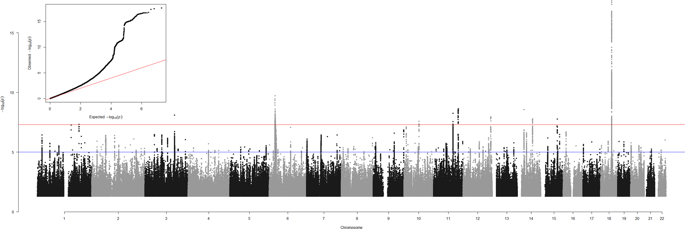当前位置:
X-MOL 学术
›
Transl. Psychiaty
›
论文详情
Our official English website, www.x-mol.net, welcomes your feedback! (Note: you will need to create a separate account there.)
Novel genome-wide associations for anhedonia, genetic correlation with psychiatric disorders, and polygenic association with brain structure.
Translational Psychiatry ( IF 6.8 ) Pub Date : 2019-12-04 , DOI: 10.1038/s41398-019-0635-y Joey Ward 1 , Laura M Lyall 1 , Richard A I Bethlehem 2 , Amy Ferguson 1 , Rona J Strawbridge 1, 3 , Donald M Lyall 1 , Breda Cullen 1 , Nicholas Graham 1 , Keira J A Johnston 1 , Mark E S Bailey 4 , Graham K Murray 2 , Daniel J Smith 1
Translational Psychiatry ( IF 6.8 ) Pub Date : 2019-12-04 , DOI: 10.1038/s41398-019-0635-y Joey Ward 1 , Laura M Lyall 1 , Richard A I Bethlehem 2 , Amy Ferguson 1 , Rona J Strawbridge 1, 3 , Donald M Lyall 1 , Breda Cullen 1 , Nicholas Graham 1 , Keira J A Johnston 1 , Mark E S Bailey 4 , Graham K Murray 2 , Daniel J Smith 1
Affiliation

|
Anhedonia is a core symptom of several psychiatric disorders but its biological underpinnings are poorly understood. We performed a genome-wide association study of state anhedonia in 375,275 UK Biobank participants and assessed for genetic correlation between anhedonia and neuropsychiatric conditions (major depressive disorder, schizophrenia, bipolar disorder, obsessive compulsive disorder and Parkinson's Disease). We then used a polygenic risk score approach to test for association between genetic loading for anhedonia and both brain structure and brain function. This included: magnetic resonance imaging (MRI) assessments of total grey matter volume, white matter volume, cerebrospinal fluid volume, and 15 cortical/subcortical regions of interest; diffusion tensor imaging (DTI) measures of white matter tract integrity; and functional MRI activity during an emotion processing task. We identified 11 novel loci associated at genome-wide significance with anhedonia, with a SNP heritability estimate (h2SNP) of 5.6%. Strong positive genetic correlations were found between anhedonia and major depressive disorder, schizophrenia and bipolar disorder; but not with obsessive compulsive disorder or Parkinson's Disease. Polygenic risk for anhedonia was associated with poorer brain white matter integrity, smaller total grey matter volume, and smaller volumes of brain regions linked to reward and pleasure processing, including orbito-frontal cortex. In summary, the identification of novel anhedonia-associated loci substantially expands our current understanding of the biological basis of state anhedonia and genetic correlations with several psychiatric disorders confirm the utility of this phenotype as a transdiagnostic marker of vulnerability to mental illness. We also provide the first evidence that genetic risk for state anhedonia influences brain structure, including in regions associated with reward and pleasure processing.
中文翻译:

快感缺乏的新全基因组关联、与精神疾病的遗传相关性以及与大脑结构的多基因关联。
快感缺失是多种精神疾病的核心症状,但其生物学基础却知之甚少。我们对 375,275 名英国生物银行参与者的快感缺乏状态进行了全基因组关联研究,并评估了快感缺失与神经精神疾病(重度抑郁症、精神分裂症、双相情感障碍、强迫症和帕金森病)之间的遗传相关性。然后,我们使用多基因风险评分方法来测试快感缺失的基因负荷与大脑结构和大脑功能之间的关联。这包括:对总灰质体积、白质体积、脑脊液体积和 15 个皮质/皮质下感兴趣区域的磁共振成像 (MRI) 评估;白质束完整性的扩散张量成像 (DTI) 测量;以及情绪处理任务期间的功能性 MRI 活动。我们鉴定了 11 个在全基因组范围内与快感缺失相关的新位点,其 SNP 遗传力估计 (h2SNP) 为 5.6%。快感缺乏与重度抑郁症、精神分裂症和躁郁症之间存在很强的正向遗传相关性;但不适用于强迫症或帕金森病。快感缺失的多基因风险与较差的大脑白质完整性、较小的总灰质体积以及与奖励和快乐处理相关的大脑区域(包括眶额皮质)较小的体积有关。总之,新的快感缺乏相关位点的鉴定极大地扩展了我们目前对状态快感缺乏的生物学基础的理解,并且与几种精神疾病的遗传相关性证实了这种表型作为易患精神疾病的跨诊断标记的实用性。我们还提供了第一个证据,表明状态快感缺乏的遗传风险影响大脑结构,包括与奖励和快乐处理相关的区域。
更新日期:2019-12-04
中文翻译:

快感缺乏的新全基因组关联、与精神疾病的遗传相关性以及与大脑结构的多基因关联。
快感缺失是多种精神疾病的核心症状,但其生物学基础却知之甚少。我们对 375,275 名英国生物银行参与者的快感缺乏状态进行了全基因组关联研究,并评估了快感缺失与神经精神疾病(重度抑郁症、精神分裂症、双相情感障碍、强迫症和帕金森病)之间的遗传相关性。然后,我们使用多基因风险评分方法来测试快感缺失的基因负荷与大脑结构和大脑功能之间的关联。这包括:对总灰质体积、白质体积、脑脊液体积和 15 个皮质/皮质下感兴趣区域的磁共振成像 (MRI) 评估;白质束完整性的扩散张量成像 (DTI) 测量;以及情绪处理任务期间的功能性 MRI 活动。我们鉴定了 11 个在全基因组范围内与快感缺失相关的新位点,其 SNP 遗传力估计 (h2SNP) 为 5.6%。快感缺乏与重度抑郁症、精神分裂症和躁郁症之间存在很强的正向遗传相关性;但不适用于强迫症或帕金森病。快感缺失的多基因风险与较差的大脑白质完整性、较小的总灰质体积以及与奖励和快乐处理相关的大脑区域(包括眶额皮质)较小的体积有关。总之,新的快感缺乏相关位点的鉴定极大地扩展了我们目前对状态快感缺乏的生物学基础的理解,并且与几种精神疾病的遗传相关性证实了这种表型作为易患精神疾病的跨诊断标记的实用性。我们还提供了第一个证据,表明状态快感缺乏的遗传风险影响大脑结构,包括与奖励和快乐处理相关的区域。



























 京公网安备 11010802027423号
京公网安备 11010802027423号